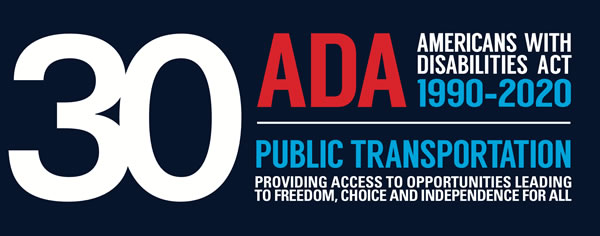
On July 26, 2020, the nation will honor the 30th Anniversary of the Americans with Disabilities Act of 1990.
Americans have more and better transportation in part because of the passage of the ADA in 1990. In the 30 years since, mobility and accessible transportation have expanded, and the public transportation industry has improved the accessibility to transit services and facilities not only for persons with disabilities, but also for all Americans.
Join APTA and public transportation industry as we celebrate this important anniversary. We’ve created this toolkit to assist you.
Resources and Information:
APTA ADA 30th logo (22h x 21w):
APTA ADA 30th logo (11h x 28w):
ADA Facts at a Glance
- The Americans with Disabilities Act of 1990 (ADA) prohibits discrimination and ensures equal opportunity and access for persons with disabilities.
- The ADA guarantees individuals with disabilities equal access to transportation. As a result, limits on accessibility to transportation for persons with disabilities must be removed if it is reasonable to do so.
- For persons with disabilities who are not able to use fixed route service, ADA requires that public transit operators provide complimentary-demand response service. Passenger trips on demand-response services increased from 68 million in 1990 to 209 million in 2019.
- Accessibility of public transit vehicles has improved markedly in the decades since the passage of ADA. According to the APTA Public Transportation Fact Book Appendix A, from 1993 to 2019 (the most recent year for which data are available), the percentage of buses that are accessible increased from 51 percent to 99.8 percent. Over the same period, the accessible portion of the commuter and hybrid rail fleet went from 32 percent to 89 percent, the light rail and streetcar fleet from 41 percent to 89 percent, the heavy rail fleet from 83 percent to 100 percent and the trolleybus fleet from 47 percent to 100 percent. The accessible portion of the demand-response fleet, where specific vehicles can be assigned to trips to meet a passenger’s individual needs, increased from 85 percent of vehicles accessible to 89 percent.
- The Federal Transit Administration works to ensure nondiscriminatory transportation in support of its mission to enhance the social and economic quality of life for all Americans. The FTA Office of Civil Rights is responsible for civil rights compliance and monitoring to ensure nondiscriminatory provision of public transit services.
- US DOT is revising its rules under the Americans with Disabilities Act (ADA) and Section 504 of the Rehabilitation Act of 1973, as amended, specifically to provide that transportation entities are required to make reasonable modifications/ accommodations to policies, practices and procedures to avoid discrimination and ensure that their programs are accessible to individuals with disabilities. The rule is effective July 13, 2015.
- Learn about the timeline of the ADA.
- View some ADA quick tax tips
- Download the Department of Transportation’s Tips for ADA compliance



